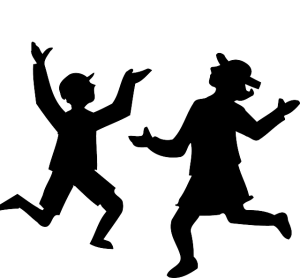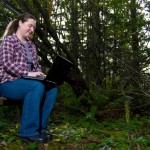Lovely write up about the DanceCraft study by the Informatics department here at UCI: http://www.informatics.uci.edu/informatics-ph-d-student-introduces-dancecraft-to-oc-autistic-children/

Lovely write up about the DanceCraft study by the Informatics department here at UCI: http://www.informatics.uci.edu/informatics-ph-d-student-introduces-dancecraft-to-oc-autistic-children/

The OC Register covered part of our research on dance for kids with autism yesterday. Check it out!
What the news article doesn’t mention is that along with dance lessons, the participants also get to take home the DanceCraft system so they can keep practicing their dance moves.
I’m happy to report I successfully passed my advancement to become a PhD Candidate!
My talk was titled “Technology Mediated Socialization for Children with Autism.”
Committee: Gillian Hayes (Chair), Rebecca Black, Mimi Ito, Josh Tanenbaum, and Tom Boellstorff
Abstract: Traditional face-to-face social interactions can be challenging for individuals with autism, leading some to perceive and categorize these individuals as less social than their peers. For example, autism can be accompanied by difficulty making eye contact, interpreting some nonverbal cues, and performing coherent verbal utterances. While these challenges can be interpreted as an inability or lack of desire for social interactions, researchers have begun to explore how to expand the definition of sociality for those with autism. My research explores how technology can support alternative means of sociality, particularly for children with autism engaged in social play. In this advancement talk, I will present two research studies: SensoryPaint and Autcraft. SensoryPaint is a multimodal sensory environment built to enable whole-body interaction with the Kinect. Evaluation of SensoryPaint was conducted in two stages: a lab-based study and a deployment study. Results from this study show how these systems can promote socialization. My second research project explores Autcraft, a Minecraft community for children with autism and their allies. I will present results from on-going ethnographic work exploring the community’s Minecraft server and other community affiliated social media. Results from this study highlight ways in which community members use technology to create a safe environment for children with autism to explore alternative forms of social expression. Findings suggest an expansion of how sociality has traditionally been conceptualized for individuals with autism and how technology plays a key role in facilitating this new sociality.
A handful of experiences and people helped to transform me from a lost undergraduate who was thinking of dropping out, to a successful, ambitious graduate student. I struggled for many years as an underrepresented student, both as a woman and as a student with a disability, to complete my undergraduate degree and find my niche in the world. Now, not only do I want to make a career of researching assistive technology, I also want to be a mentor for those who follow me, just as I had mentors to guide my way.
As the only woman in my undergraduate computing classes, I faced adversity and isolation. I sought support and attended the Grace Hopper Celebration of Women in Computing Conference (GHC). Upon learning that I was one of many women facing isolation in their computing courses, I founded an ACM-W Chapter for women in computing at Washington State University Vancouver (WSUV). I felt the need to create greater participation of college women in computing, a support network for them, and a way to mentor freshmen and high school girls. As the chair of the chapter for the first year, I planned a campus-wide event to encourage women to pursue computing careers and spoke at a panel discussion. The event hosted 40 women from campus and the local community and received very positive feedback. The women from the community college who had not considered pursuing a four-year degree until they heard our panel inspired me. I have continued to mentor one young woman who is now pursuing her undergraduate degree in computer science and intends to continue on to graduate school.
On my graduate school campus, University of California Irvine (UCI), I am involved in a similar group: Women in Information and Computer Sciences (WICS). I volunteered with WICS in summer 2013 to mentor middle and high school girls interested in computing. In fall 2013, I also helped start a graduate chapter of this group. As a graduate student representative for UCI, I attended GHC 2014 as a student volunteer. My connections with these groups led me to other opportunities, such as conducting research and presenting at two academic conferences, as well as mentoring underrepresented undergraduates.
Through my experiences with the women in computing groups, I have realized how important mentorship is for those in the early stages of their careers. Through teaching and mentoring, I have been able to ignite my passion for helping others through research with students and also pass along valuable skills that they will use in their future studies. During my first year as a graduate student, I led a diverse team of undergraduates, all of whom are underrepresented minorities, in the development of a whole-body interface application on the Microsoft Kinect for children with autism. I encouraged my team to work together to solve problems and learn how to collaborate effectively. I also coached them in giving a presentation to the lab about their work. Continuing this project, I have expanded the scope of the software, and have begun working with a professor from the Dance Department to create new avenues of therapy for children with autism. One of the undergraduates I mentored has since graduated with a B.S. in Informatics and is now applying to graduate school.
In an effort to serve my local community, I volunteer as an instructor for technology use workshops for young adults with autism who are transitioning into the workplace from high school. In a more formal setting, I have also had the opportunity to be a teaching assistant for undergraduate level courses. As part of my responsibilities, I have worked with students one-on-one, as well as leading discussion sections of more than 40 students. In addition to regular discussion lectures, I also gave a guest lecture to the entire class of 250 students. Knowing the importance of mentorship for undergraduates, these varied teaching experiences increase my desire to seek a position that allows me to continue mentorship my PhD.
Individuals with autism and other neurodevelopmental disorders often experience sensory perception impairments, which can lead to challenges such as sensitivity to loud noises or irritation from specific textures on their skin. Atypical movement, such as rocking, can be exhibited as compensation for this sensory perception impairment.
Currently, therapists use dance therapy to stimulate the various senses in children with autism to help reduce atypical movement and to increase engagement in the activity. DanceCraft is a system developed to further the aims of dance therapy by increasing the children’s body awareness. We will be exploring how the software engenders different interactions styles to help inform the design of future systems focused on using body based movements to support dance therapy.


 I am happy to announce that our paper, “SensoryPaint: A Multimodal Sensory Intervention for Children with Neurodevelopmental Disorders” has received Best Paper Nomination at Ubicomp 2014. Many thanks to my awesome co-authors as well as others who helped with editing and other feedback. I presented this paper Sept 17, 2014.
I am happy to announce that our paper, “SensoryPaint: A Multimodal Sensory Intervention for Children with Neurodevelopmental Disorders” has received Best Paper Nomination at Ubicomp 2014. Many thanks to my awesome co-authors as well as others who helped with editing and other feedback. I presented this paper Sept 17, 2014.
Full citation here:
Dance Buddy animation is complete!
Yeah, that’s me being completely ridiculous after a very long day of programming.
© 2024 Kate Ringland, PhD
Theme by Anders Noren — Up ↑